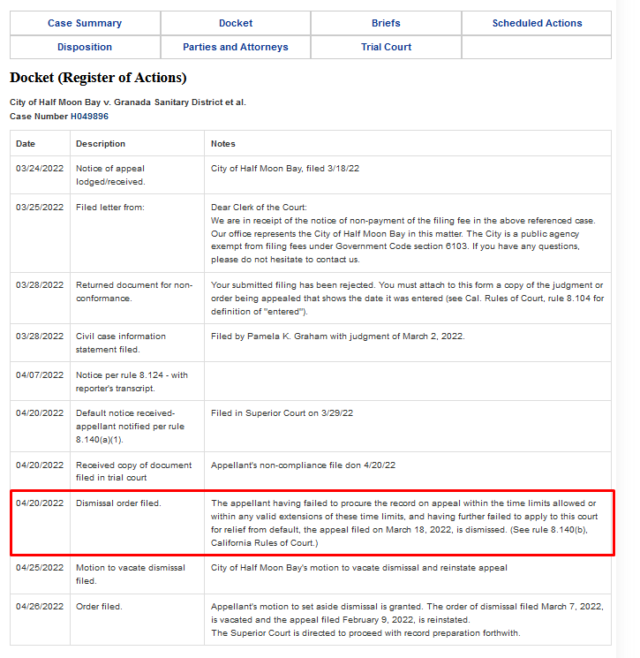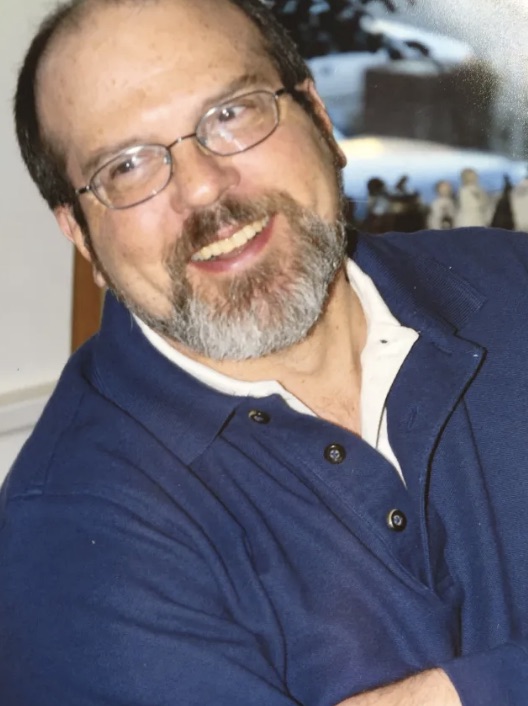|
Getting your Trinity Audio player ready...
|
OWN VOICE. ~ InPerspective by Gregg Dieguez —
We almost saved some money… On April 20th the Court dismissed HMB’s appeal of their sewer lawsuit against their partners in the Sewer Authority Mid-Coastside (SAM). But by the time I finished researching and writing this article, things changed, again. Still the recurring disinformation about the lawsuit requires me to raise an important point: how HMB saves millions annually from having partners in SAM.
Images: Click to enlarge for improved readability in a new window.
You can follow the progress of the lawsuit at this link, or read the screenshot below. HMB failed to pay the fees necessary to process the appeal, claiming they were exempt from the fees. When I passed this information around, leading citizens of HMB agreed that this was an inadvertent good thing, and gave me some colorful quotes:
 “It would be wonderful if simple incompetence resulted in getting the right thing done!”
“It would be wonderful if simple incompetence resulted in getting the right thing done!”
But the city has just reinstated their appeal of the judge’s decision (details here). As we have covered here before, HMB has sued to avoid paying their fair share of an integral part of the shared SAM wastewater system, the Intertie Pipeline System (IPS), claiming in press releases that the IPS costs $20 million and provides no benefit to HMB residents. There are several things wrong with those claims. Listed at the bottom are the significant benefits HMB residents receive from the IPS, and you can read prior analyses of the lawsuit and those issues, but my analysis shows HMB saves millions of dollars a year because of its partnership in SAM.
What if HMB didn’t have partners in SAM?
Suppose MWSD and GCSD were vaporized by a comet, or otherwise removed themselves from the SAM partnership? Yes, the costs of the IPS would be removed, and let’s pretend the IPS will cost the $20M that HMB claims. Without the IPS and with no partners, that would leave ~$100 million in the SAM asset foundation for HMB to replenish on its own. Those assets are at least halfway into their useful life, in spite of recent replenishment projects. Right now, HMB is responsible for 60% of future SAM asset replenishment costs on about $120M (including the IPS), which is $72M. Without partners, they would instead be responsible for 100% of $100M. That’s a savings of $28M, plus inflation over time.
And all those assets WILL need to be replaced again, someday. And the assets that replace them will need to be replaced. And so on and so on. In Public Works, “once an asset, always an asset” and the failure to recognize the perpetual nature of asset replenishment is what has the entire Nation behind the 8-ball in its infrastructure. Add to those numbers the inflation in replacement cost that affects Every Single Asset Every Single Year, and you have a perpetual asset management problem that requires perpetual financial diligence to manage. So, taking the long view, every Public Works asset has an infinite cost, but that’s not the argument HMB was making about the IPS. In fact, without an IPS, HMB would have even more of a sewer system asset burden to fund.
In addition, if we look separately at the operating costs of the SAM system, HMB would likely save some chemicals and electricity, but I doubt a single plant operations staff member would be disposable. One might argue some overhead management and staff could be removed, but that would add workload to other HMB staff, and lose focused expertise regarding SAM – nevertheless estimate that at $500K annual savings. The SAM budget for this year is $7.4 Million. Right now HMB’s share is $4.2M. Without its partners, and assuming half a million in savings, HMB would be on the hook for $6.9M per year, and growing. That would be an increase of $2.7M in costs per year. Thus, the overlooked key benefit to HMB is that they get to SHARE COSTS with partners, which is why Montara was dragged into this (forced to discard a new, working sewer plant) to begin with.
I am aware that some perceive my tone regarding this lawsuit as “snarky”, but I’m not alone in finding this lawsuit both unjustified and counterproductive. The quote above was an unsolicited reply from a leading HMB figure. And there are lots of other people up here in the north who are variations of angry and disgusted with HMB for both the lawsuit and their misrepresentations of it. We’ve already wasted over $1 million in attorney fees on this lawsuit. Unless the leaders of HMB can be convinced to drop this lawsuit, I foresee a longstanding resentment lingering among coastside residents. And what is truly tragic is that this legacy of ill will need NOT be fomented, and cannot help us move forward together in addressing the severe economic and environmental challenges we all face.
________________________________
Benefits HMB receives from the IPS:
In summary, the IPS benefits HMB in five (5) ways: (see also: Rush To Judgment… SAM Lawsuit Update)
1. It allowed HMB to upgrade a failing sewer plant at less cost than doing it themselves, and split the costs of property, construction, and operation with its neighbors. And the cost savings are described above ^^.
2. It gives HMB protection against severe wet weather events, when SAM plant operators can turn off the flow from the north and hold the sewage in wet weather storage at the Portola and/or Walker tanks in Montara, so that HMB can consume 100% of the plant’s capacity. Which has happened at least four times in recent memory (e.g. this past Dec. 13th).
3. The IPS also serves all parts of HMB proper north of the SAM plant, including the “Cherry Stem” up to the Pillar Pt. Harbor – thus parts of HMB are served by GCSD sewers and HMB is suing its own residents there.
4. The IPS allows SAM staff to perform maintenance on the plant by shutting parts of it down. As HMB has no wet weather sewer storage of its own, tanks in the IPS can be used to hold sewage back at the pump stations until work is done. This has occurred several times, e.g. when the Force Main had breaks and had to be fixed. Also, while laying new force main or while doing major plant repairs, sewage can be held upstream. Similarly, when major plant electrical work must be done, sewage has been held upstream in the IPS (as happened again last month).
5. The IPS has served as an equalization basin to reduce flows while SAM processes a backlog of waste and/or to even out flows (e.g. during a drought) so that a minimum fluid volume is always available and septicity doesn’t build up in the system.
More From Gregg Dieguez ~ InPerspective
Mr. Dieguez is a native San Franciscan, longtime San Mateo County resident, and semi-retired entrepreneur who causes occasional controversy on the Coastside. He is a member of the MCC, but his opinions here are his own, and not those of the Council. In 2003 he co-founded MIT’s Clean Tech Program here in NorCal, which became MIT’s largest alumni speaker program. He lives in Montara. He loves a productive dialog in search of shared understanding.







Sigh! Once again, Half Moon Bay stamps it’s foot to get their way without considering the greater good of the entire Community. I wish for not simply judicial “justice” but also economic justice. While it would be expensive to separate, it would be interesting, if not peptic justice, if this City posturing ended up separating the districts and put the entire burden of the old SAM Plant problem on the HMB rate payers (who must be in the dark over this lawsuit.)
I don’t hear any HMB Citizens saying “Rah Rah” so I can’t see how they feel justified wasting so much on legal fees when that same money could be going towards much needed repairs.